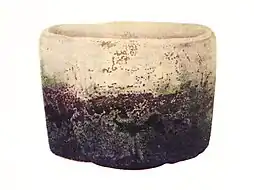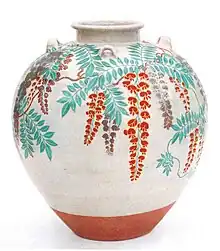.jpg.webp)
Tobe ware (砥部焼, Tobe-yaki) is a type of Japanese porcelain traditionally from Tobe, Ehime, western Japan. It is of the sometsuke (染付) blue and white pottery type.
The ware started making its appearance when Katō Yasutoki, 9th lord of the Ōzu Domain (1769–1787), started hiring potters from Hizen. Production of white porcelain (hakuji) commenced in An'ei 6 (1777).[1]
In 1976 it was officially designated by the government as a traditional crafts.[2][3]
The products are characterized by a slightly thick, rugged base and fine brush strokes.[4][5]
References
External links
![]() Media related to Tobe ware at Wikimedia Commons
Media related to Tobe ware at Wikimedia Commons
- http://www.tobeyaki.co.jp
- Tobe Ware page by Kyoto Women's University, Lifestyle Design Laboratory
This article is issued from Wikipedia. The text is licensed under Creative Commons - Attribution - Sharealike. Additional terms may apply for the media files.

